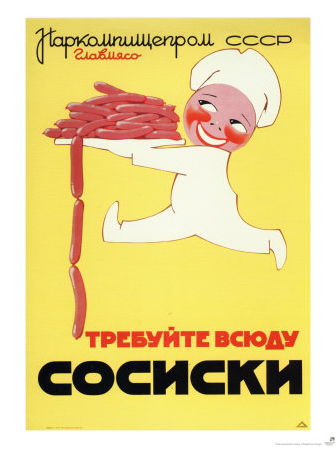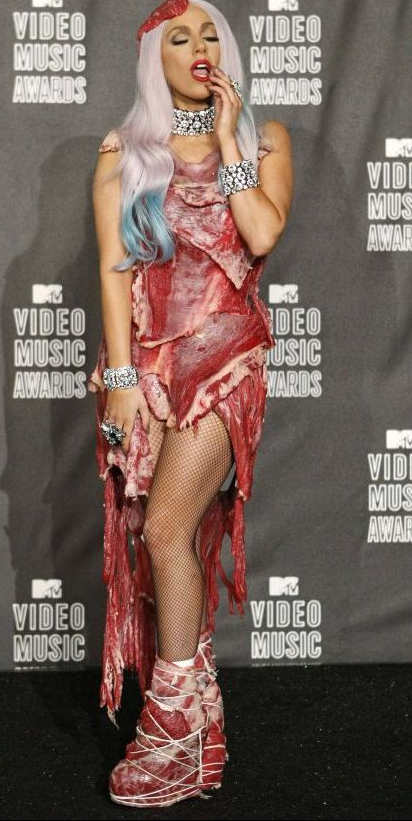Meat Markets
December 18th, 2011
The Artist of the Month for June 2011 is Alisa Baremboym.
Artist Richard Phillips selected Alisa. Her print, Cured, is printed with archival ink on silk, with hand-sewn edges. Here, we discuss her print, her imagery, and her “process.”
MB: Can you describe the relationship your work has to food? Is it diaristic, like a periodic index of what you eat? Is it about what other people eat? Or do you hope it provokes a viewer’s visceral response?
AB: In using food, I work around the idea of the preserved body. We preserve animal bodies as food in order to extend their life as a biological energy for our own bodies, thus further preserving ourselves. This continuous process loop, like an endless sausage link, relates to our own co-dependent relationship of need and desire.
MB: Regarding your 2009 work, Chuchela, ArtReview wrote, “Baremboym pins a group of cultural references together, flattening them into a shallow pile so that cultural relativity is extruded and we are subtly muscled into considering our own specific relationship to these signifiers around which she plots her narrative points.” Could that interpretation apply to Cured? It embodies and invokes cultural references, and the flattened, shallow pile seems unmistakeable. And making processed meats involves both “extruding” and “muscle.”
AB: Our visible bodies are the external packaging of our layered interiors. Silk can act like a second skin in the same way that ‘natural casing’ envelops the processed meat. In “Cured,” the repeated pattern is meant to extend beyond the fabric’s borders, but ends by the force of the object’s edge. It attempts to be infinite but becomes finite, much like preservation. Culture in this case is not only relative, but a relative byproduct of the need to survive.
MB: Yet, the edge is a catalyst. The edge converts this from a repeated pattern to an object – and an object of a special class. Beyond dimensions and materials, this object has market value, cultural esteem, and archival considerations. It’s indispensable, unlike a food photo in a catalog, menu, or advertisement. Is this implied in the title? To be “cured” implies conversion. Have you cured – converted – this image from the commonplace? Or is it the opposite, and you’ve cured – liberated – it from the rarefied art context?
AB: Framing a limitless pattern is a way to underline the artifice of the image and it’s relationship to the way reality and depictions of reality interact. There is always an element of translation or conversion that exists in my work and also exists in the basic act of making something. Through the lens of photography, I am framing the subject in a way that is always a translation of what it actually is. The photograph is then transferred to a print on silk which is another translation. I am propelled by the idea that images further extend the shelf life of a consumable thing, but ultimately for a finite amount of time. The title “Cured” describes the general act of preserving something so it opens up the conversation beyond just what is depicted in the image.
MB: As cultural objects, these processed meats convey a different priority than a roasted chicken, a pig on a spit, or even a carcass hanging in New York’s Meatpacking District. They also mean something different than a hot dog. And a hot dog seems more American. Does “Cured” have a particular culture in mind?
AB: There are many cultures that use and have used cured meat as part of their cultural histories and traditions. It is more of a symbol of those cultures including my own Russian/American background than a specifically American example of a hot dog, per se. I am interested in the specificity as well as the universality of the sausages depicted because that allows the image multiple meanings and creates part of the tension.
MB: You see the conversion of animal life into biological energy as a process loop. In your view, how is it a process loop more than a food chain, which is more vertical, unilateral, and pyramidal? American meat consumption is an environmental catastrophe, and I wonder how this relates to the infinite/finite conditions you described above, and the need to survive.
AB: The co-dependence is between our own need and desire in relation to sustaining ourselves with things like food and clothing, for example. Our patterns of eating and other biological necessities, make up the pattern of our everyday lives. Repetition gives the illusion of the infinite. The notion of an infinite supply of food is completely false, yet we somehow have that impression based on what we see as consumers in the western world. In this case, culture is a byproduct of our daily lives in the sense that what we develop out of necessity gets refined or processed and becomes culture.
MB: What is the closest you’ve come to wearing a second skin?
AB: We all wear a second skin in the form of clothing, protecting us from the elements on a daily basis. Clothing has a similar relationship to necessity and luxury that food does, which is one of the reasons I choose to combine them.




